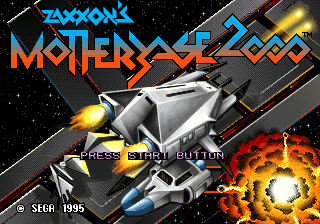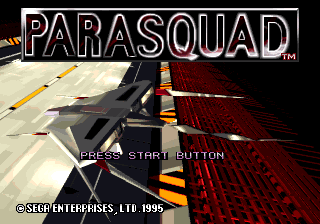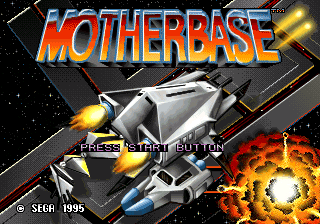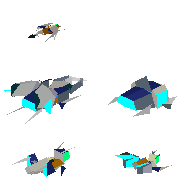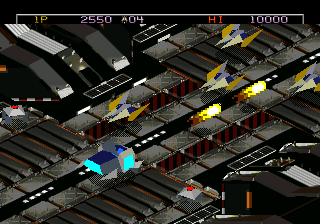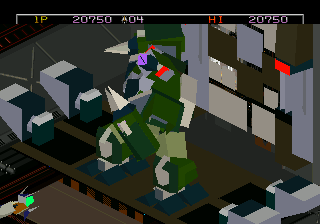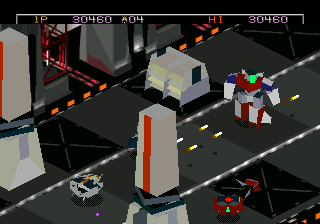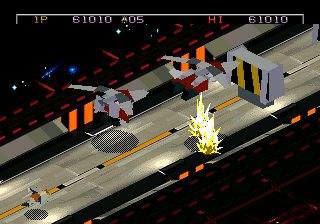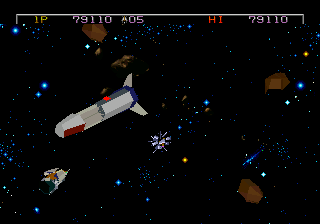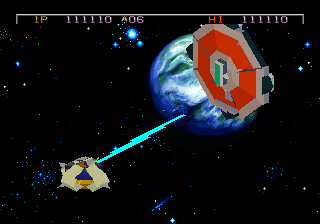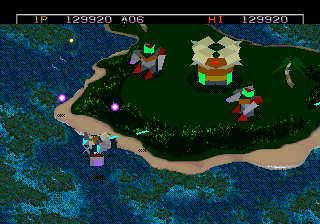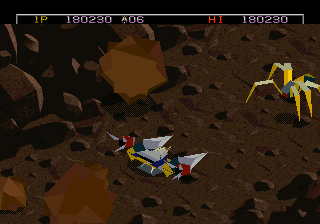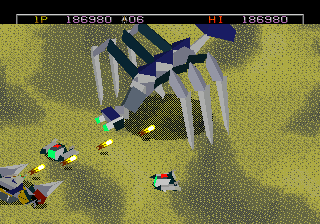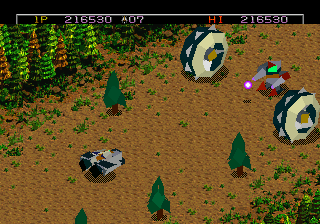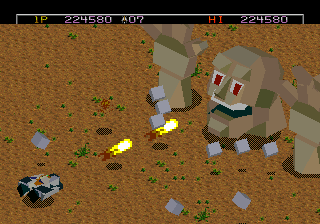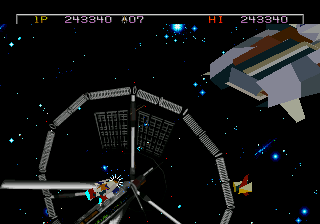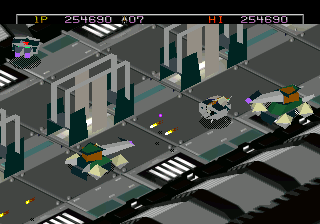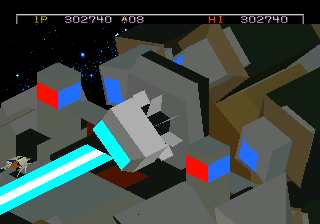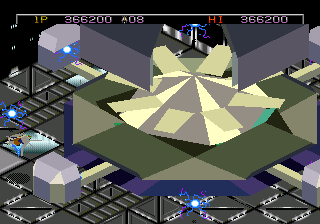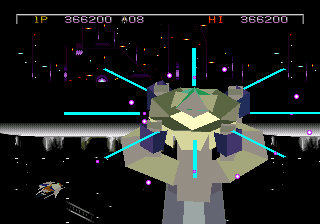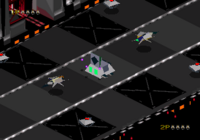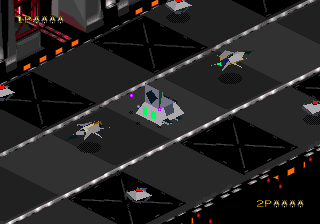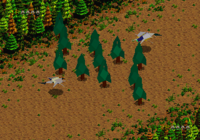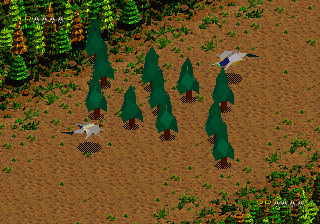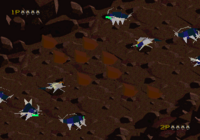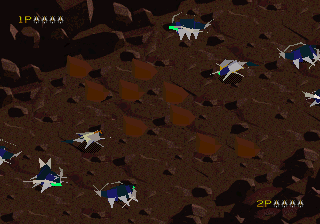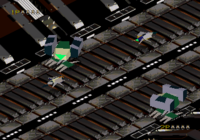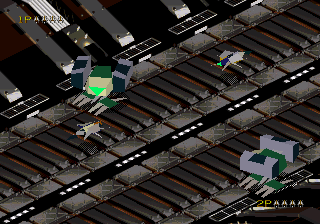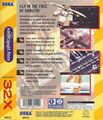Zaxxon's Motherbase 2000
From Sega Retro
| ||||||||||||||||||||||||||||||
| Zaxxon's Motherbase 2000 | ||||||||||||||||||||||||||||||
|---|---|---|---|---|---|---|---|---|---|---|---|---|---|---|---|---|---|---|---|---|---|---|---|---|---|---|---|---|---|---|
| System(s): Sega 32X | ||||||||||||||||||||||||||||||
| Publisher: Sega Enterprises, Ltd. (JP, EU), Sega of America (US) | ||||||||||||||||||||||||||||||
| Developer: CRI | ||||||||||||||||||||||||||||||
| Sound driver: SMPS Z80 | ||||||||||||||||||||||||||||||
| Genre: Shooting[1][2] | ||||||||||||||||||||||||||||||
| Number of players: 1-2 | ||||||||||||||||||||||||||||||
|
Zaxxon's Motherbase 2000, known in Europe as Motherbase (which was also a working title) and in Japan as Parasquad (パラスコード), is a shoot-'em-up released by Sega for the Sega 32X. Despite its North American title, the game has no connection to the arcade game Zaxxon aside from both being isometric shooters set in space.
The game runs at about 20 FPS during gameplay, with slight dips when there are too many objects on-screen.
Contents
Story
The Hive Confederation was once a peaceful planetary system of intelligent insectoids until the separation of the Ginglii clan. The Ginglii created a computer that can coordinate the production of weapons and have overtaken and enslaved numerous Hive planets. A rebellion force has begun a mission, codenamed "Motherbase 2000," to fight through the Ginglii defenses and reach the computer.
Gameplay
The game is an autoscrolling shoot-'em-up played from an isometric point of view where the player flies a spaceship, the Stinger, through enemy bases. The Stinger moves with the D-Pad and fires its standard weapon with ![]() . By default, the movement of the ship is relative to the perspective of the player rather than following the isometric view (similar to Viewpoint), but it can be changed to control similarly to the original Zaxxon. Weapons do not have rapid-fire by default, but this can also be changed in the options before starting the game. The Stinger has a rocket booster mounted to its underside and can "jump," increasing its altitude momentarily, with
. By default, the movement of the ship is relative to the perspective of the player rather than following the isometric view (similar to Viewpoint), but it can be changed to control similarly to the original Zaxxon. Weapons do not have rapid-fire by default, but this can also be changed in the options before starting the game. The Stinger has a rocket booster mounted to its underside and can "jump," increasing its altitude momentarily, with ![]() , which can be used to hop over enemy fire.
, which can be used to hop over enemy fire.
Allied spacecraft, called couriers, appear throughout the stages. The Stinger can take over these craft by jumping onto them with ![]() . Couriers vary in size and armor. Each is equipped with its own unique weapons systems, including a secondary weapon that is fired with
. Couriers vary in size and armor. Each is equipped with its own unique weapons systems, including a secondary weapon that is fired with ![]() . All weapons have unlimited ammunition. The Stinger exits a courier with
. All weapons have unlimited ammunition. The Stinger exits a courier with ![]() . The game begins with the Stinger already in a courier, the Pincer, but starts subsequent stages on its own.
. The game begins with the Stinger already in a courier, the Pincer, but starts subsequent stages on its own.
Additionally, the Stinger can hijack some enemy ships by docking onto them in the same manner as couriers. This requires some experimentation to learn which enemies can be docked since the Stinger is destroyed if it attempts to land on a ship that cannot be docked. Like couriers, enemy craft have unique weapons, including secondary weapons. The player receives "Hacking" bonus points for each enemy ship taken over. If the player pilots the ship until a lightning effect appears (accompanied by a voice sample saying, "Ready"), the Stinger "learns" the enemy craft's primary attack (retaining this weapon as the Stinger's secondary attack even after ejecting from the craft) and the player earns "Learning" bonus points as well.
The Stinger is destroyed by any hit from enemy fire or a collision. Couriers and enemy ships can take multiple hits before exploding (destroying the Stinger as well). Heavier armored couriers can withstand more abuse than lightly armored couriers. Ships do not take damage from hitting the walls of the stage. The game does not directly indicate how much damage a ship has taken, though couriers visually lose parts as they are damaged. The status bar flashes red when the ship is about to destruct. Ships cannot be repaired, but the player can jump to another vessel. If the ship is destroyed, the player loses a life and must restart the stage from the beginning in the Stinger (with no courier). If the player runs out of lives, the game ends, but it can be continued as long as there are continues remaining. The player earns extra lives at 50,000 and 100,000 points and then every 100,000 points after that.
The game also features a versus mode where two players face off in a small arena. Whoever destroys the opposing player's ship five times wins. There are multiple arenas, which have their own obstacles and hazards.
Ships
| 924 Stinger | |
|---|---|
|
Speed: Average Armor: Light Primary weapon: Light Cannon | |
| The Stinger is the base ship, which can dock into any of the other ships, called couriers, as well as many enemy vessels. It is capable of fighting on its own, but it is more fragile than other craft. Its primary armament is a quick-firing light cannon. It has no secondary weapon, but if it "learns" the weapon of an enemy after hijacking it, it becomes assigned to the Stinger's secondary weapon. | |
| Pincer 24-H | |
|
Speed: Slow Armor: Heavy Primary weapon: Heavy Cannon Secondary weapon: Ripper Missiles | |
| The Pincer is slow-moving and heavily armored. Its primary weapon is a cannon that shoots two strong shots in parallel; it can have up to three pairs of shots out at a time. Its secondary weapon is firing two heat-seeking Ripper Missiles. | |
| Beetle 16-B | |
|
Speed: Slow Armor: Heavy Primary weapon: Type 12 Cannon Secondary weapon: Plasma Mines | |
| The Beetle is slow-moving and heavily armored. Its primary weapon is a single powerful cannon; it can have two shots out at a time. Its secondary weapon is deploying two Plasma Mines that land and explode (or explode if they hit an enemy before landing). | |
| R95 Mantis | |
|
Speed: Average Armor: Average Primary weapon: Twin Heavy Lasers Secondary weapon: Spitter Missiles | |
| The Mantis is equipped with twin lasers. It can shoot Spitter Missiles, up to two at a time, which are standard missiles that fly to the end of the screen. | |
| T159 Wasp | |
|
Speed: Fast Armor: Light Primary weapon: Medium Laser Secondary weapon: Needle Missiles | |
| The Wasp is the fastest moving ship. It is lightly armored and equipped with medium lasers, similar to the Mantis but not as powerful. These lasers are fired singly; there can be up to three out at a time. Its secondary weapons are fast-firing, heat-seeking Needle Missiles. |
Stages
| Stage 1 | |
|---|---|
| Stage 2 | |
| Stage 3 | |
| Stage 4 | |
| Stage 5 | |
| Stage 6 | |
| Stage 7 | |
| Stage 8 | |
| Stage 9 | |
Arenas
These are small arenas without scrolling that are used in the two-player mode.
Versions
Localised names
| Language | Localised Name | English Translation |
|---|---|---|
| English | Motherbase | Motherbase |
| English (US) | Zaxxon's Motherbase 2000 | Zaxxon's Motherbase 2000 |
| Japanese | パラスコード | Parasquad |
Production credits
- Main article: Zaxxon's Motherbase 2000/Production credits.
Magazine articles
- Main article: Zaxxon's Motherbase 2000/Magazine articles.
Promotional material
Physical scans
| Sega Retro Average | ||||||||||||||||||||||||||||||||||||||||||||||||||||||||||||||||||||||||||||||||||||||||||||||||||||||||||||||||||||||||||||||||||||||||||||||||
|---|---|---|---|---|---|---|---|---|---|---|---|---|---|---|---|---|---|---|---|---|---|---|---|---|---|---|---|---|---|---|---|---|---|---|---|---|---|---|---|---|---|---|---|---|---|---|---|---|---|---|---|---|---|---|---|---|---|---|---|---|---|---|---|---|---|---|---|---|---|---|---|---|---|---|---|---|---|---|---|---|---|---|---|---|---|---|---|---|---|---|---|---|---|---|---|---|---|---|---|---|---|---|---|---|---|---|---|---|---|---|---|---|---|---|---|---|---|---|---|---|---|---|---|---|---|---|---|---|---|---|---|---|---|---|---|---|---|---|---|---|---|---|---|---|
|
| 64 | |
|---|---|
| Based on 28 reviews | |
Technical information
- Main article: Zaxxon's Motherbase 2000/Technical information.
External links
- Sega of America webpage: 32X
References
- ↑ File:Parasquad 32x jp frontcover.jpg
- ↑ 2.0 2.1 http://sega.jp/fb/segahard/32x/soft.html (Wayback Machine: 2013-06-19 13:31)
- ↑ 3.0 3.1 3.2 GamePro, "July 1995" (US; 1995-xx-xx), page 48
- ↑ Electronic Gaming Monthly, "June 1995" (US; 1995-0x-xx), page 128
- ↑ Computer Trade Weekly, "" (UK; 1995-09-18), page 96
- ↑ 6.0 6.1 Mean Machines Sega, "July 1995" (UK; 1995-05-27), page 70
- ↑ CD Consoles, "Juillet/Août 1995" (FR; 1995-xx-xx), page 110
- ↑ Consoles +, "Juillet/Août 1995" (FR; 1995-0x-xx), page 130
- ↑ Electronic Games (1992-1995), "July 1995" (US; 1995-0x-xx), page 73
- ↑ Electronic Gaming Monthly, "June 1995" (US; 1995-0x-xx), page 36
- ↑ Famitsu, "1995-07-21" (JP; 1995-07-07), page 1
- ↑ GameFan, "Volume 3, Issue 6: June 1995" (US; 1995-xx-xx), page 16
- ↑ Game Players, "Vol. 8 No. 7 July 1995" (US; 1995-0x-xx), page 42
- ↑ GamesMaster, "August 1995" (UK; 1995-07-06), page 50
- ↑ Games World: The Magazine, "August 1995" (UK; 1995-06-29), page 68
- ↑ Game Informer, "June 1995" (US; 1995-0x-xx), page 39
- ↑ Hobby Consolas, "Agosto 1995" (ES; 1995-xx-xx), page 82
- ↑ MAN!AC, "07/95" (DE; 1995-06-14), page 66
- ↑ Mega Fun, "07/95" (DE; 1995-06-21), page 82
- ↑ Next Generation, "July 1995" (US; 1995-06-20), page 71
- ↑ Player One, "Juillet/Août 1995" (FR; 1995-0x-xx), page 118
- ↑ Play Time, "(8/9)/95" (DE; 1995-07-05), page 92
- ↑ Saturn Fan, "1995 October" (JP; 1995-09-08), page 72
- ↑ Sega Magazine, "July 1995" (UK; 1995-06-15), page 92
- ↑ Sega Power, "September 1995" (UK; 1995-07-20), page 46
- ↑ Sega Pro, "August 1995" (UK; 1995-07-13), page 52
- ↑ Sega Saturn Magazine, "August 1995" (JP; 1995-07-07), page 77
- ↑ Todo Sega, "Septiembre 1995" (ES; 1995-0x-xx), page 44
- ↑ Top Consoles, "Septembre 1995" (FR; 1995-0x-xx), page 88
- ↑ Última Generación, "Junio 1995" (ES; 1995-0x-xx), page 96
- ↑ Video Games, "7/95" (DE; 1995-06-28), page 100
- ↑ VideoGames, "July 1995" (US; 1995-0x-xx), page 61
| Zaxxon's Motherbase 2000 | |
|---|---|
|
Main page | Comparisons | Maps | Credits | Hidden content | Magazine articles | Reception | Region coding | Technical information | |
| Games in the Zaxxon Series | |
|---|---|
| Zaxxon (1981) (home computers) | Super Zaxxon (1982) | Zaxxon Super Game (1984) | Zaxxon 3D (1987) | Zaxxon's Motherbase 2000 (1995) | Zaxxon Escape (2012) | |
| Others | |
| Zaxxon (LCD) (1982) | FL Zaxxon (1982) | Zaxxon (tabletop) (1982) | Zaxxon (board game) (1982) | |
| Zaxxon related media | |
| The Official How to Win at Zaxxon (1982) | |
